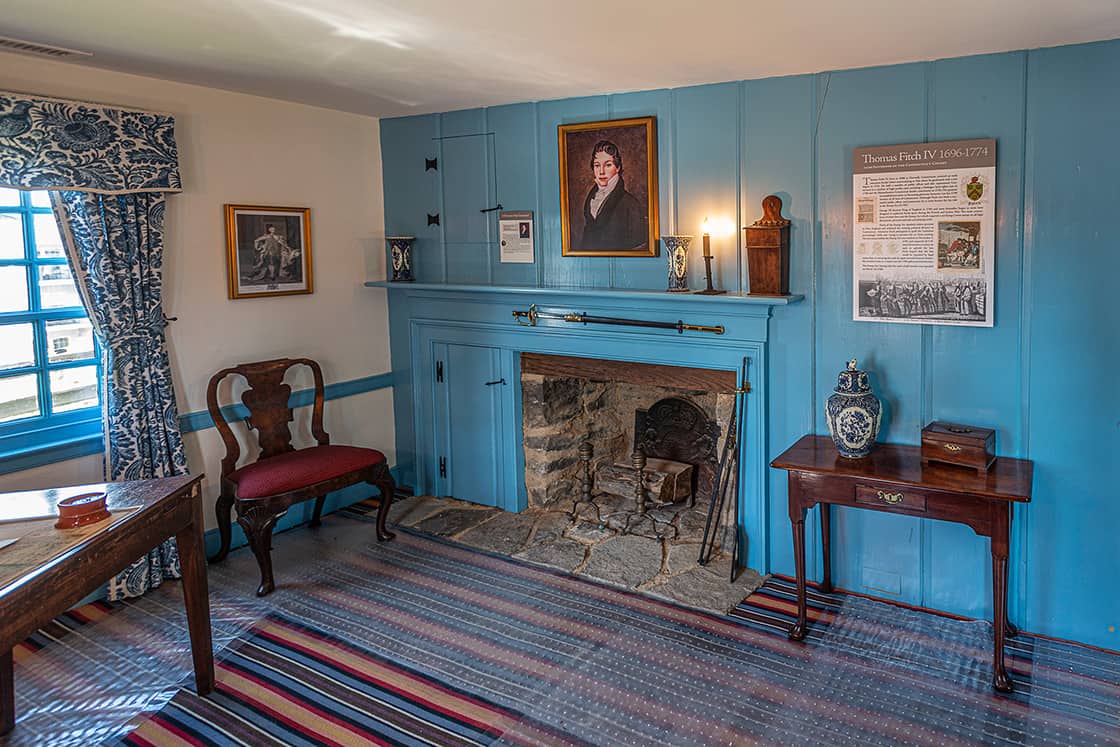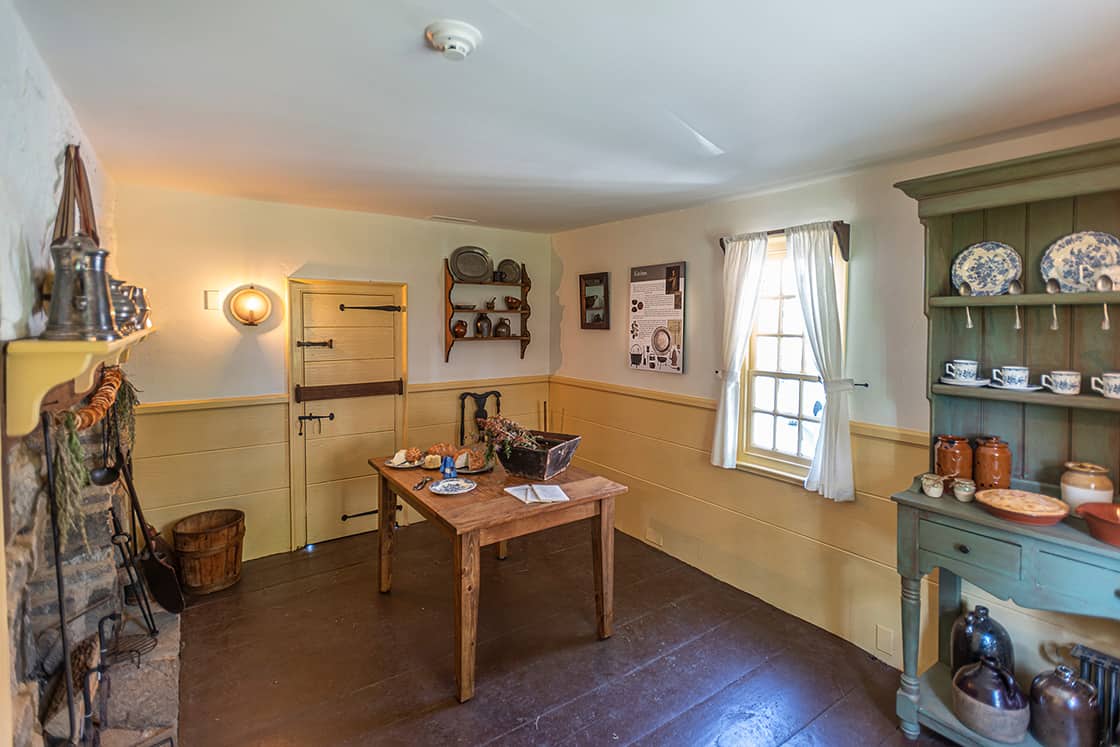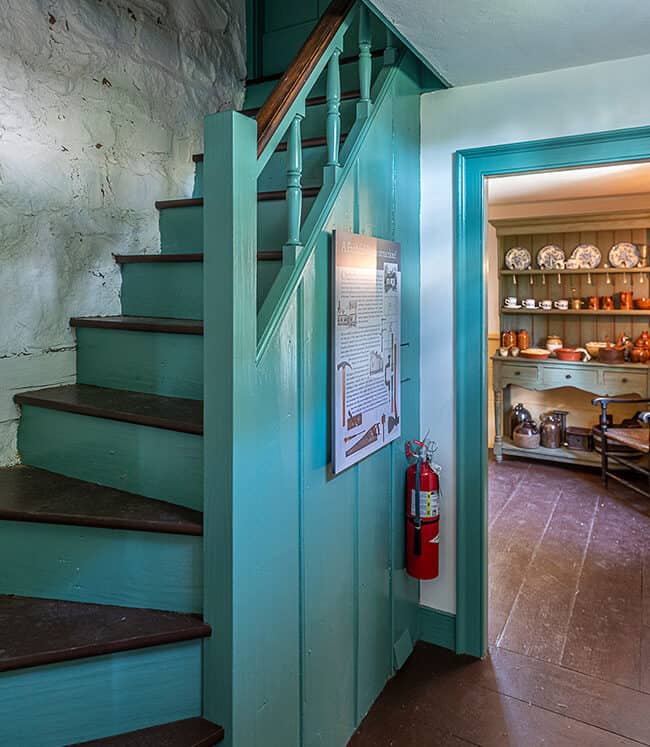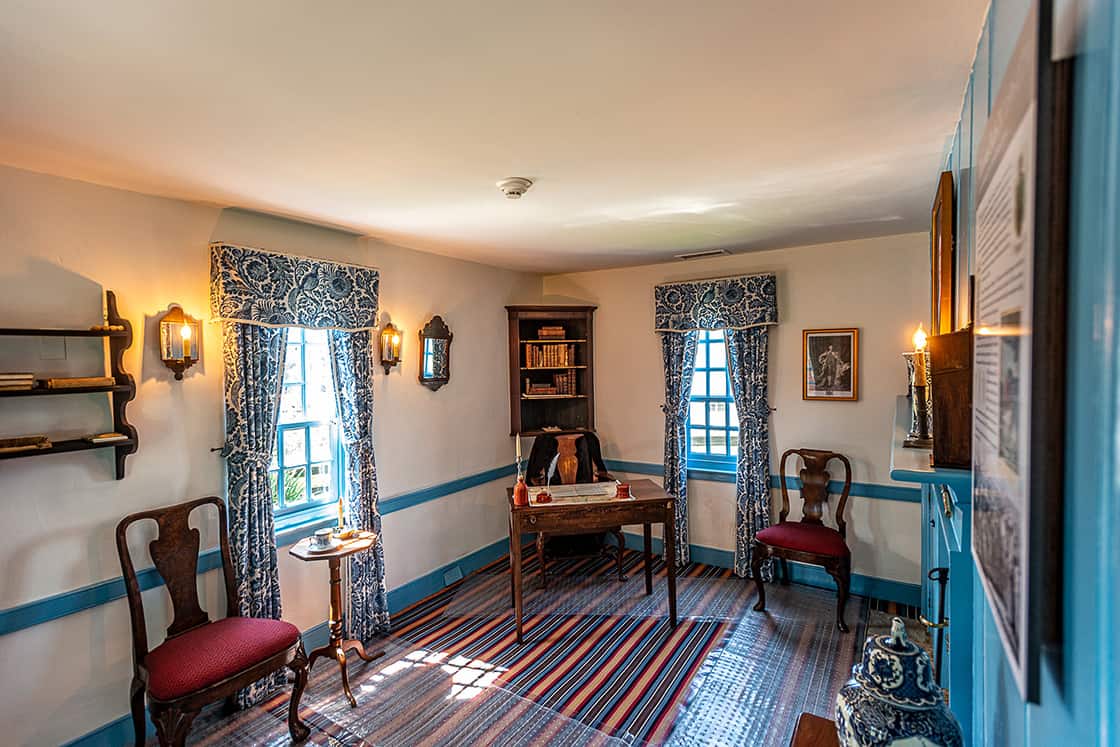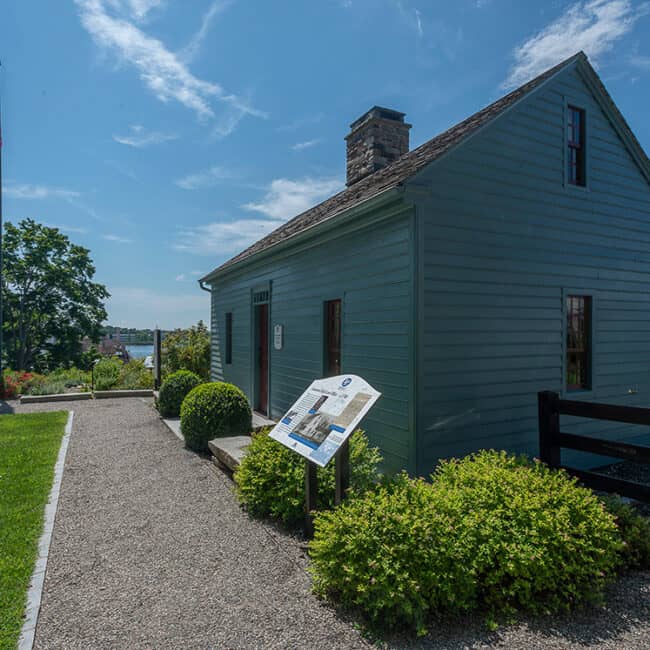Gov. Fitch Law Office Restoration
The Reinterpretation of 2018
As part of the 2018 reinterpretation of the Fitch House, a comprehensive study of previous finishes was undertaken. Samples were taken from all wood paneling, floors, windows, doors, mantelpieces, moldings and surrounds. The resulting report uncovered a series of colors on most surfaces with base colors and oils on the downstairs doors indicating faux graining was utilized. The earliest identified colors appropriate to the time period were selected and corroborating paint purchased from the Benjamin Moore Historical Series including Lafayette Blue, Westminster Gold and French Horn. A specialist able to recreate faux wood graining was hired to refinish the doors on either side of the entryway.
Photos: Tod Bryant
Dr. Daryn Reyman-Lock is a native of Connecticut. After graduating from Lehigh University with a B.S. in Geologic Sciences and a B.A. in Archaeology, she matriculated to the University of Nottingham in England to complete a Masters and Ph.D. in Archaeology. Her research is concerned with the social constructs of space and phenomenology.
Upon returning to the United States in 2012, she began working as a historic preservation specialist. Dr. Reyman-Lock often works closely with non-profits to curate exhibits, catalogue and move museum collections, and research historic landscapes and buildings. She also consults for municipalities on a variety of projects.
About the Fitch Law Office Restoration

If Thomas Fitch VI, the fourteenth governor of the Colony of Connecticut (1754-1766), were with us today, he would find himself quite at home in the familiar surroundings of the restored law office. He would recognize the warmth of the pine boarding and the aroma of linseed oil paint, as well as the friendly scale of the small building and the spaces within.
To him, all would seem as it should be, except for the electric lamps and the exposed hewn timbers. The lamps, he simply would not believe. The exposed hewn timbers, visible in the cellar and attic, would appear to him to be strangely aged with a dusty-brown pallor brought on by the wear and tear of two centuries.
In his use of the building today, the Governor would have no idea that his office was being heated by electric coils buried in the ceiling, or that there were devices called convenience outlets concealed in walls and floors. Aside from the twentieth-century metal dampers in the fireplaces, he would find no further visible changes in the law office building.

The following notes present some of the more interesting facts about the restoration.
Stones from the cellar walls of the original Fitch House were used in constructing the foundations and chimney of the law office. The small screened openings in the tops of the walls are not traditional however, and are installed to provide ventilation.
Inside the building, the joints in the chimney are clay, fine salt hay, and cattle hair. The clay came from the original 1699 chimney in the Old Hoyt Farmhouse in Stamford, Connecticut. This house is now the headquarters of the Stamford Historical Society.
Hewn timber repairs were made with the use of material salvaged from the kitchen wing of the post-revolutionary Fitch House, supplemented by old broad-axed beams from Roxbury, Connecticut.
Jointing and fastening of the windows matches the old sash in the Judson House in Stratford, Connecticut with the frames and muntins mortised and pinned with wood dowels. This house is a fine example of a 1720 building and is owned by the Stratford Historical Society.
Glass used in glazing the windows is of the colonial period, obtained from East Haddam, Connecticut. Special skill was required in cutting the panes to size, since old glass varies in thickness, is out of plane and tends to be very brittle.
Nails and hardware are hand-wrought, and were fashioned by an expert in the field, using traditional tools and an old forge. Close inspection will reveal the characteristic “maker’s mark” on some of the pieces.
Details of the design were taken from typical examples of early 18th century work. This involved measuring and photographing many of the original examples.
The front entrance was patterned after the 1725 Philo Bishop House in Guilford, with proportions scaled down and simplified for our smaller building. The rear door is the original, with battens added for additional strength.
The mantel in the Lawyer’s Office follows the design of one at “White Farm,” in Long Hill. This has the typical batten door to the wood box, and cupboard door above.
Many examples exist of fireplaces similar to the one in the Clerk’s Office, which is quite small for a cooking fireplace of the period. However, the size of both the fireplace and the dutch oven are adequate for the needs of the law clerk. A fireplace very similar to this exists in the Lewis House, in Norwalk.
The wood wainscot in the Clerk’s Office matches the original. Evidence of this woodwork was discovered in a corner under many layers of paint and wallpaper.
Inspection of the stairs will reveal two different types of construction, neither of which are used in building today. The cellar stairs, with continuous oak stringers and bracketed risers, have their counterpart in the Bushnell House, in Saybrook. The Pierpoint House, in New Haven has a flight of attic stairs with construction matching the Fitch stairs. Both have housed treads and risers, together with dovetailed block supports for the treads underneath the steps.

General design of the railing at the attic stairs follows the pattern of the Pardee House in Montowese. The vertical boarding at this stair run was donated by Andrew Kish and Warren Palmer of Norwalk, and came from the Jarvis-Grumman House on East Ave.
A close look at the floor boards in the Lawyer’s Office and Attic Chamber will reveal the characteristic marks of the “up and down” saw used in early work. Much of the material utilized in repairs to the flooring came from old houses that had been demolished in the Norwalk Redevelopment Area.
Coming down the stairs from the Attic, a visitor may notice a small square panel in the plaster all ahead. The panel shows the construction of the plastering, starting with split wood lath, which was fastened with hand-made nails. As in the original work, the plaster contains clay and cattle hair.
Except for the wiring and lamps, the lighting fixtures are exact reproductions of colonial pieces, and were hand-produced in the shop of Gates Moore, in Silvermine. Notice should be made of the owner’s initials worked into the cut-out pattern on the large lantern in the Porch.
All of the paint colors were carefully chosen to match examples of the period. The grey color is the original shade of the rear door to the Clerk’s Office, and a door in the Attic. The green in the Lawyer’s Office is from the 1710 Rose House in Branford. This building is not far removed from Yale College, which was attended by Thomas Fitch.
The balance of the colors were taken from the authentic room exhibits of the period at the Metropolitan Museum of Art.
Restoration of the Governor Fitch Law Office proved to be a very demanding, yet fascinating project for the architect. A multitude of people were contacted, and countless places were visited in piecing together the puzzle of the restoration.
Credit for outstanding help in sharing their store of knowledge of 1740 buildings should be given to Mrs. F. Doughty Kingsbury, Mr. F. Bradford Taylor and Mr. Harry Boyd, all of Norwalk. Much advice was also received from Mr. John D. Curtis, of Old Sturbridge Village, and Mr. Herbert Darbee, Associate Director of the Connecticut State Historical Commission.
This project would not be a reality today except for the farsightedness and diligence of many people, including members of the Mayor’s Historical Sites Committee; the Norwalk Chamber of Commerce; former mayor of Norwalk, Frank Zullo; the Norwalk Historical Society, under the leadership of Mr. Ferenz Fedor; Mr. Ralph Bloom, Curator of Historic Buildings for the City of Norwalk; Mr. John Vassos; and Mr. Eric DeMarsh.
The restoration work on the building was directed by the Mayor’s Historical Sites Committee, under the chairmanship of Mr. John Cuneo, attorney and local historian.
This building restoration was constructed by the George O’Brien Company, of Greenwich, Conn., with funds provided by the City of Norwalk and the State Historical Commission.
John Gaydosh, Architect
William Blum, Associate


